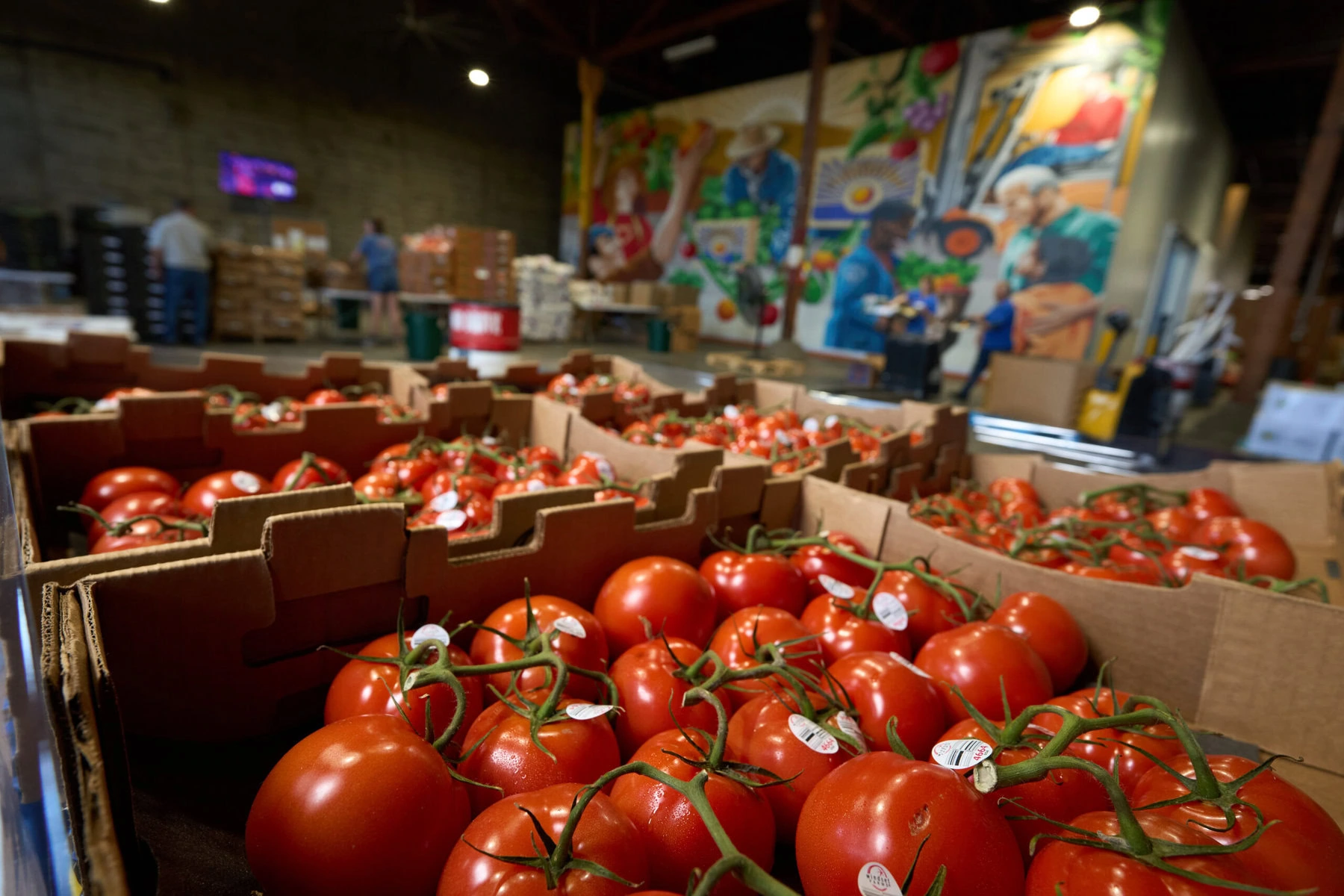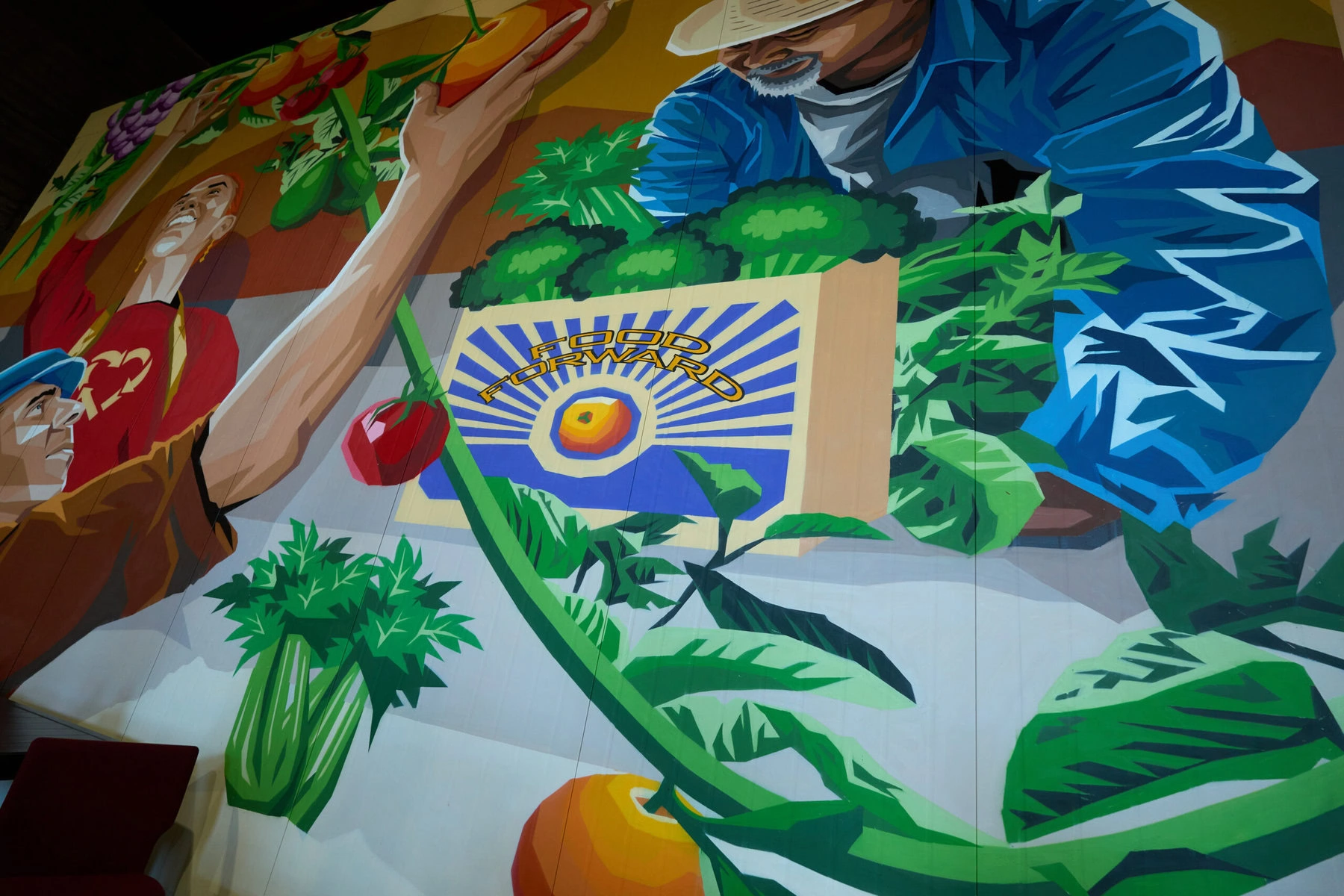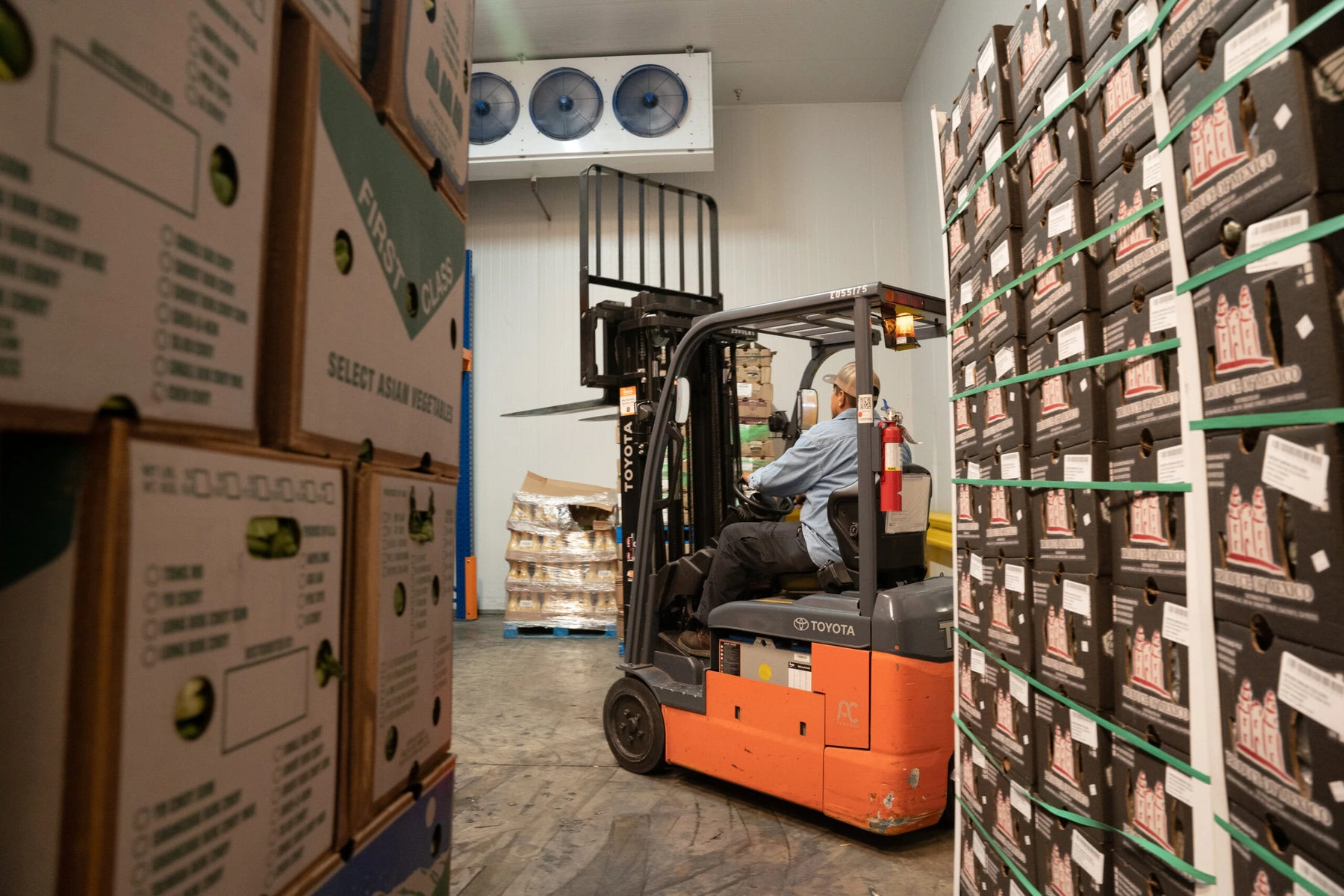This story was originally published by Reasons to be Cheerful
The day at the “Pit Stop” warehouse in Bell, California, starts at 4 a.m. Forklifts move pallets of tomatoes, broccoli and bell peppers into trucks. Boxes of grapes and bananas wait to be loaded while trucks arrive with an abundance of zucchinis and nectarines. The 10,000-square-foot warehouse looks like organized chaos: A dozen employees move an average of 265,000 pounds or 132 tons here every day. “Share the Abundance” is written in bright blue letters across a yellow wall. The best part: All this healthy abundance is free. The nonprofit Food Forward receives the fruits and vegetables at no cost from wholesalers and donates them to those in need in 13 counties.
“Because we focus 100 percent on perishable fresh fruit and vegetables, speed is of the essence,” says Jen Cox, Food Forward’s Chief Development Officer. “Hardly any produce stays here for more than 24 hours. The logistics are insane.”
In the US, more than 35 percent of the food produced (roughly 92 billion pounds) gets thrown out every year, amounting to an annual loss of $408 billion. At the same time, every fifth family is food insecure. Food Forward operates to fill that gap and solve both problems at once, hustling to distribute fresh food before it goes to waste.
Since its inception 15 years ago, it has rescued 217,000 tons of produce and distributed it to nearly 300 hunger relief partners, mostly in Los Angeles and surrounding counties, but every so often a truck of surplus travels as far as Texas. “We are providing enough food every day that would meet the USDA recommended daily requirements for 270,000 people,” Cox explains. “It equals millions of dollars’ worth of food they don’t have to buy if we can just grab it in time and move it.”
Preventing food waste also benefits the climate, not only because of the resources, water and energy invested in food production but also because food waste in landfills is one of the main sources of the climate gas methane. “Last year, we prevented the emissions of more than 21,000 metric tons of CO2e,” Cox says. “That’s the equivalent of taking 4,571 cars off the road for a year. And we prevented 1.4 billion gallons of water from going to waste in 2023, the equivalent of 2,129 Olympic-sized swimming pools.”

Credit: Leroy Hamilton
The mountains of food that Food Forward moves are especially remarkable given that the nonprofit started as the simple, local idea of one man. In 2009 the photographer Rick Nahmias was walking through his San Fernando Valley neighborhood and noticed many citrus trees laden with ripe fruit. “What if this food could do more than end up in the trash?” he asked himself. “Could it help feed people who are hurting right now?” He put an ad on Craigslist to find helpers, and out of the eight people who responded, one actually showed up.
Over the following three weekends, Nahmias, friends and volunteers harvested over 800 pounds of unwanted tangerines and oranges, donating all of it to local food pantries.
This was the beginning of Backyard Harvest, a coordinated volunteer-driven gleaning operation that still continues as part of Food Forward today. Nahmias, now the founding CEO of Food Forward, says, “It feels good to help people and build a community, but it is also simply fun.”
Crushed by negative news?
Sign up for the Reasons to be Cheerful newsletter.
In its first year, volunteers picked 100,000 pounds of fruits from orchards and donated all of it. Six thousand and six hundred owners of backyards and orchards are registered with Food Forward, giving permission to glean their harvest when it’s ripe.
In 2011, Food Forward began picking up unsold food from vendors at the Santa Monica farmers market, eventually adding 16 more farmers markets to its Farmer’s Market Recovery Program. A single farmers market can yield 2,000 pounds of surplus.
By expanding to wholesale operations in 2014 and adding its refrigerated warehouse in Bell in 2019, Food Forward was able to multiply the volume of fruit and vegetables it handles. The Los Angeles wholesale market is the largest in the country, and Food Forward rescued four million tons of produce from it in its first year.

“It’s a win-win, because the wholesalers would otherwise need to pay to get rid of it,” Cox explains, “so we’re helping them, but also feeding people.”
From the humble backyard beginnings grew an organization with 53 full-time employees and nearly 1,300 volunteers, five box trucks plus one electric 53-footer Volvo semi-truck. With a budget of $6.3 million last year and just over $8 million this year, Food Forward is able to provide fresh produce at a cost of $0.07 per pound, though none of the recipients pay a cent for it.
“We try to get food that is still good for several days,” Cox says, and emphasizes that none of the food they distribute is second-rate. “It could be that a product has been mislabeled and therefore cannot get sold in a store, that happens more often than you think, or bumper crop, or there is a truck with tomatoes on the way, but the supermarket knows they will get another truck with fresher tomatoes tomorrow, so we take it.” The success is also rooted in knowing which nonprofit can handle what. “Who will be delighted by a truckload full of bok choy and who wants pomegranates?” Cox gives as examples. “For smaller organizations, we often pack smaller bags with varied produce that they can readily distribute.”
Food Forward partners with 300 local and regional nonprofits that give the food to seniors, veterans, after-school programs, tribal lands and food-insecure families, mostly in LA County plus occasional truckloads to other states. It was recognized by the White House earlier this year as part of the Biden-Harris administration’s initiative to end hunger and is committed to collecting 100 million pounds of produce by 2026, up from 87 million pounds last year.
While Food Forward is the largest operation of its kind in California, nonprofits in other states operate with similar missions, for instance, City Harvest in Brooklyn and Philadelphia’s PhilAbundance, plus many smaller regional organizations.

“When we can’t take a load, we try to connect with other nonprofits,” Cox says. Surprisingly, the biggest challenge Food Forward is facing is not lack of food, but logistics and infrastructure. “Often, there is more food available to us. The hardest thing for our staff is when we have to say no because our warehouse is already full or we have already accepted a truckload of tomatoes,” Cox says. “It’s hard to wrap your head around the volume of the issue. We always want to find a way. What would it take to do more?”
Sometimes this means directing a donation to other states and delivering it as far as Texas, but mostly, the produce benefits people in Southern California. Smaller food pantries often don’t have refrigeration and are particularly grateful for the addition of healthy greens to their staples.
“Every time we bring someone a salad or something fresh, they really light up — you can see it — so you know they’re feeling better that day,” says Michael, a delivery driver for one of Food Forward’s partners. Recipients include MEND (Meet Each Need with Dignity), Seeds of Hope, West Valley Food Pantry, Bernardi Multi-Purpose Service Center and more.
“Food Forward helped us get nutritious, fresh whole foods to these communities that would rarely be able to access it to begin with,” comments Yuri Mitzkewich, the program leader of the international nonprofit Vegan Outreach. “They’d be priced out of it, even if they were able to get some.”
And Cari Golden, founder of Lov Kitchen in Los Angeles, uses the produce to create healthy meals for the homeless. “Without Food Forward, we wouldn’t have a service to provide,” she says. “Food Forward is the reason we can get healthy meals to the unhoused population on Skid Row.”
Food Forward’s close partnerships recently expanded to reach even more children. Brighter Bites works with schools to bring produce and nutrition education to children and their families. Since 2023, Food Forward has been the primary source of produce for this multi-pronged approach to health, diet and food access in 13 schools in Los Angeles.
“Food Forward was a game changer for us,” Lisa Helfman, the co-founder of Brighter Bites, says. “We would not be able to serve the Los Angeles community without them.”
The post The Californians Rescuing Surplus Produce to Fight Hunger appeared first on Reasons to be Cheerful.




